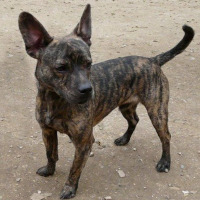Appearance of the French Bull Dane
|
| The French Bull Dane could adopt the French Bulldog's small, sturdy body, as well as its pug nose and bat ears. The French Bulldog also has a rounded forehead and a flat but proportionate head. These dogs will have an underbite and large, round eyes. Their tail can be corkscrew or straight, depending on the dog. This breed has a square appearance, as the length from withers to tail is about the same as the height of the withers. They can also be described as pear-shaped, as the shoulders are a little wider than the back. Great Danes are huge, elegant, muscular dogs that are proportionally square with body height corresponding to length. Their head has medium-sized, square ears, set high and sometimes cropped. If not cropped, the ears fold back towards the cheek. Their tails, which are never cropped, will taper to a point. Your French Bull Dane will have an interesting mix of both, and puppies in the same litter can vary considerably. |
Temperament of the French Bull Dane
|
| Given the French Bull Dane's parents, we can determine that this hybrid dog will make a very good pet. The French Bulldog is a wonderful breed with a gentle, affectionate personality. These little dogs can be mischievous and stubborn to train, but are easy to handle. They generally get on very well with other pets or people they meet. This breed will become very attached to its family and may become sad or develop separation anxiety if left alone for long periods. Great Danes are powerful, intelligent and fearless, making them the perfect dog for hunting wild boar. Today, they are loyal and affectionate pets. They also make excellent guard dogs, as their size makes them quite intimidating. Although protective, these dogs are gentle giants who wouldn't cause harm if they didn't have to. Children should not be left unsupervised with Great Danes, simply because they can sometimes forget how big and powerful they are. They are moderately intelligent and should be fairly easy to train. |
Needs and activities of the French Bull Dane
|
| The French Bulldog has a low activity level and will be content with a few short walks a day, as well as a little fetch and play time. In adolescence, the Great Dane can be quite energetic and will need to be walked regularly. In the early years, your French Bull Dane should not jump or run excessively, to prevent joint problems. The amount of activity required of the breed will depend on the individual dog. However, it will most likely be between 30 and 120 minutes of exercise a day, as these are the requirements of the parent breeds. Individual personality and temperament will determine exercise requirements. |
Maintenance of the French Bull Dane
|
| The French Bull Dane will develop a fairly simple coat to maintain, as both parents are generally easy to care for. The French Bulldog needs weekly brushing just to keep the coat clean and shiny, but will not need regular bathing or clipping. Great Danes are fairly heavy excretors and will need weekly brushing with a firm bristle brush. In some cases, people have opted for professional help with nail trimming and bathing, as the French Bulldog can be large and difficult to handle if uncooperative. Keep their nails trimmed every month or two. Brush his teeth every day, or at least two or three times a week. Clean and check your dog's ears every week to prevent infections. |









 English (United Kingdom)
English (United Kingdom)